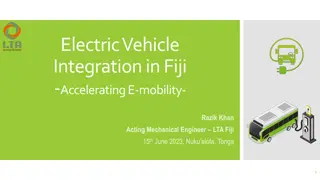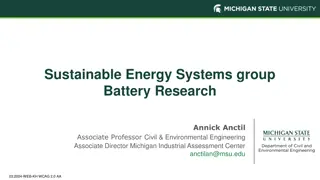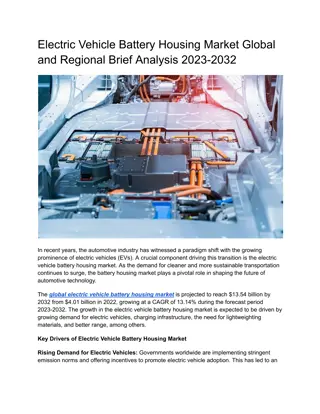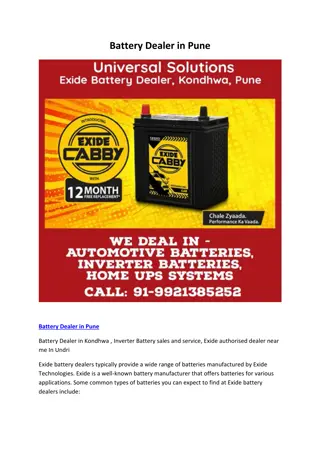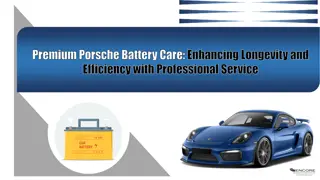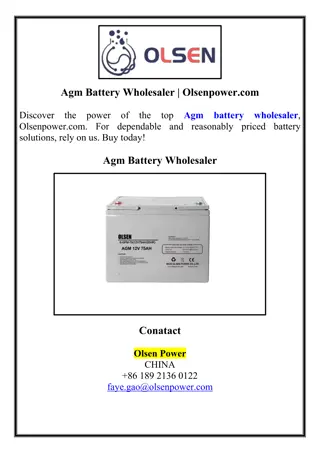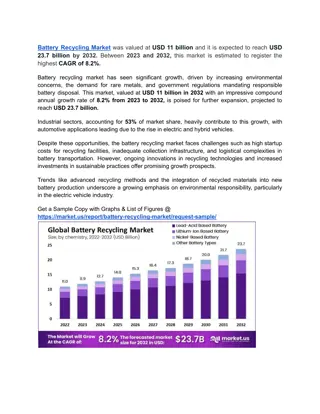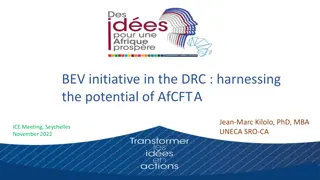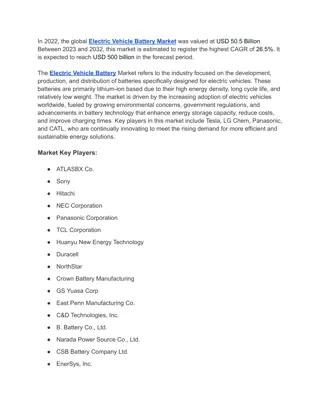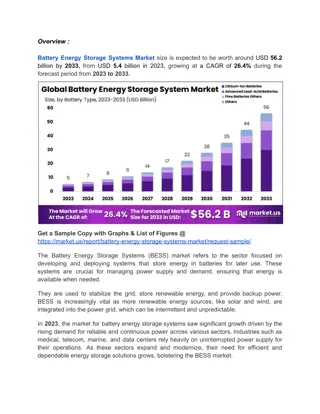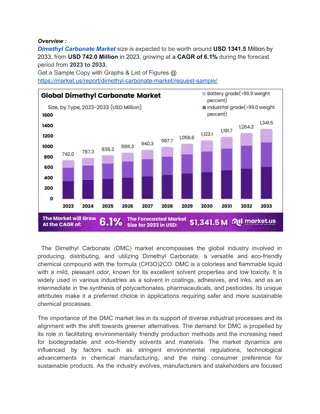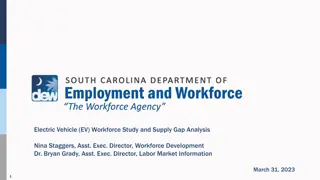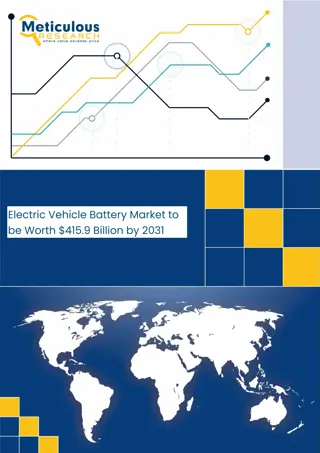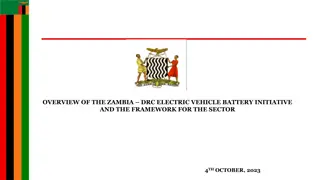Understanding the Electronic Vehicle Battery Industry
Exploring the electronic vehicle battery industry, this content delves into the manufacturing processes, cost breakdown, challenges, and areas for cost improvement. Key components like lithium-ion cells, raw material costs, and critical materials such as lithium, cobalt, and nickel are discussed. The industry's current landscape, future projections, and strategies for cost reduction are highlighted.
Download Presentation

Please find below an Image/Link to download the presentation.
The content on the website is provided AS IS for your information and personal use only. It may not be sold, licensed, or shared on other websites without obtaining consent from the author. Download presentation by click this link. If you encounter any issues during the download, it is possible that the publisher has removed the file from their server.
E N D
Presentation Transcript
Understanding the Electronic Vehicle Battery Industry Aritra Pal -03/22/2021
EV Assembly Process Li-ion batteries make for the most expensive component of an electric vehicle, accounting for 40-50% of the cost
Li-ion Cell Manufacturing Process TATA CHEMICALS 25-30% 35-40% 30-40% Cell Components Li-ion Cells Chemical Compounds Battery Pack Mining (Anode, Cathode etc.) Lithium: Bolivia, Argentina, Chile Cobalt: Australia, Congo Nickel: Indonesia, Australia, Brazil No mines in India 80% capacity in China No capacity in India - Manikaran Power Ltd. from 2024 CATL, Panasonic, LG Chem, Tesla- Panasonic India - Epsilon Advanced Materials No present capacity in India In Future - TDS, Li Energy, BHEL, Amara Raja, CUMI, Exicom, GOCL, Jyoti CNC, Thermax, Sukhbir Agro, NALCO Presently - 1 GWh annual capacity In Future - Exide, Amara Raja, Panasonic, Mahindra, Adani, Reliance, ATL, Hero
EV Battery Cost Breakdown Battery Cost Breakdown % Raw Material Cost Breakdown % 5.5 2.3 14.3 8.8 22.4 52.1 28.1 18.6 Raw Material Capital Equipment Overhead & Other Labor Cathode Other Cell materials (Case, Straps etc.) Anode Electrolyte
Li-ion Cell Diagram Highest Cost due to Imports
Challenges in EV Battery Production Zero in-house availability of key raw materials: Lithium, Cobalt, and Nickel High Fixed Costs due to Large Capital Investment Cost Disadvantage vs Global Peers High Import Costs No Li-ion battery components made in India Li-ion battery costs can be reduced by up to 80% on larger volumes. 50GWh capacity to achieve global parity in costs Complex, Fast changing Cell Technology
Cost Improvement Areas Cathode Cathode is the largest component of battery cost 3 oxide types in use - Nickel Cobalt Aluminum oxide, Nickel Manganese Cobalt oxide, Lithium Iron Phosphate Cobalt is the most expensive material within the cathode, so formulations of these materials with less cobalt typically lead to cheaper batteries Nickel cobalt aluminum oxide has the lowest cost-per-energy-content and highest energy-per-unit-mass Inactive cell materials Contribute nearly 36% of cell Improving cell design to reduce inactive materials
Cost Improvement Areas (Contd.) Recycling to extract Li, Co & Ni
Govt. of India Inititatives Increased Import duty of Li-ion cells to 10% from April 2021(from 5%) Increased Import duty of EV Battery Packs to 15% from April 2021(from 5%) Approved PLI schemes worth a financial outlay of 18,100 Cr. over a 5 yr. period in Advanced Chemistry Cell(ACC) Battery State Govt initiatives Gujarat Maharashtra Andhra Pradesh Tamil Nadu Karnataka
References https://cleantechnica.com/2019/07/28/lithium-ion-battery-manufacturing- heating-up-in-india/ https://evreporter.com/lithium-ion-battery-manufacturing-in-india/ https://www.pv-magazine-india.com/2019/03/12/li-ion-cells-face-doubled- import-duty-from-april-2021/ https://evreporter.com/lithium-ion-cell-manufacturing-in-india-guide-for- msmes/ https://www.ien.com/product-development/news/21141505/ev-battery- costs-explained https://auto.hindustantimes.com/auto/news/why-are-electric-cars- expensive-the-cost-of-making-and-buying-an-ev-explained- 41603419957680.html https://qnovo.com/82-the-cost-components-of-a-battery/ https://www.energy.gov/eere/vehicles/articles/fotw-1128-april-6-2020- innovations-automotive-battery-cell-composition






